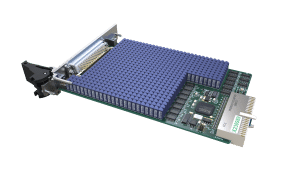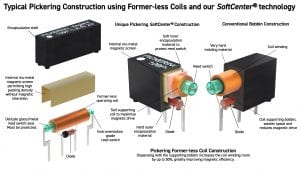Reed relay is differentiating factor for ultra-high-density PXI matrix
Last year, Pickering Interfaces, the manufacturer of modular signal switching and simulation products for use in electronic test and verification, launched a new generation of 1 amp PXI matrices that delivers twice the density of competing modules.
One of the key components in any module of this type is the switching element – the reed relay – and it was developments made by sister company Pickering Electronics to its reed relay product range that has enabled Pickering Interfaces to get a performance advantage over its rivals.
Unlike the age-old chicken/egg conundrum, (NB: it was the egg), there is no disputing which Pickering company came first. Pickering Electronics began producing reed relays in 1968; Pickering Interfaces was formed in the mid 1980s to broaden the company’s product portfolio when it appeared that solid state relays might eventually supersede reed and electromechanical products. It has transpired though that over 30 years later, the applications for reed relays have not declined. Pickering Interfaces has grown to become a leader in its field, claiming to offer the largest range of switching and simulation products in the industry for PXI, LXI, and PCI applications. Pickering’s products are specified in test systems installed throughout the world and have a reputation for providing excellent reliability and value.
The company’s latest product is the BRIC™ ultra-high-density large PXI matrix range (model 40-559), robust 1 amp/20 watt switching modules, with up to 4,096 crosspoints. The matrices are available in 2, 4, or 8-slot PXI sizes and are designed for high-performance matrix requirements. They are used in many industries including automotive ECU and semiconductor package testing. Keith Moore, CEO at Pickering Interfaces, claims that the new BRIC PXI matrices “deliver twice the density of any competing module” – similar-sized offerings from close competitors “can only claim around 0.3 amp/3 watts”, he adds.
The key to this significant increase in capability is Pickering Electronics’ continual innovation of the reed relay. Despite advances by electromechanical relays – which can be cheaper but are slower and shorter-lived than reeds – and solid state switches – which are faster than reeds but which suffer from having a lower insulation resistance, a higher capacitance and path resistance – “reed relays are still the critical building block for PXI matrices”, claims Moore.
Over the years, Pickering Electronics has pioneered several developments in reed relay design. One was the incorporation of a Mu-metal magnetic screen which enables relays to be packed very tightly together without risking operational failure due to magnetic interaction with adjacent relays. To this day still, some competitor’s products are unscreened.
Another development introduced by Pickering Electronics is the use of a former-less coil construction. Having a self-supporting coil dispenses with the supporting bobbin commonly found in competing reed relays. This increases the space available for coil winding by about 50% greatly improving magnetic efficiency. It also enables further product miniaturisation.
When designing its new BRIC PXI matrix range, Pickering Interfaces wanted to create a product that would enable a complete Functional ATE switching system to be housed in a single 3U PXI chassis and allow the use of much lower cost 8 or 14-slot PXI chassis. The model 40-559 matrices are designed with built-in, high-performance screened analogue busing to minimize the cost and complexity of cable assemblies to the device under test as well as to instrumentation. The range also includes Pickering’s Built-in Relay Self-Test (BIRST) and is also supported by their eBIRST Switching System Test Tools. These tools provide a quick and simple way of finding relays that have been damaged or reached their end of life within the modules.
Pickering Interfaces’ previous generation PXI modules use series Pickering Electronics’ series 117 reed relays, which, when launched, were the smallest products available on the market, with a footprint measuring 6.86 x 3.81 mm (0.27 x 0.15 inches). In order to achieve the doubling in switching density required to achieve its goals for the new matrices, Pickering Interfaces approached its sister company to see if any further space savings could be achieved.
“It was definitely a case of the application leading the product development”, says Moore, “and the new 120 series product they have produced occupies the smallest board area – a mere 3.9 x 3.9mm – while enabling the highest packing density currently available”.
 The new reed relays are available in two switch types: a general-purpose sputtered ruthenium switch rated for up to 20 watts and 1 amp and a low-level sputtered ruthenium switch rated at 10 watts and 0.5 amps. The reed switches are oriented vertically within the package, significantly improving the packing density. However, the small package size cannot accommodate an internal diode: back EMF suppression diodes are included in many relay drivers, however, if they are required, depending on the drive method, diodes can be provided externally. Internal mu-metal magnetic screening is included – otherwise dense packing of the relays would not be possible due to magnetic interaction. While Pickering do not normally recommend connectors as they do compromise resistance integrity, it is understood that these are sometimes desirable to aid serviceability. The relay pins on 2mm pitch are compatible with some connectors in the market place and allow them to be stacked in either a row or in a matrix on a 4mm pitch.
The new reed relays are available in two switch types: a general-purpose sputtered ruthenium switch rated for up to 20 watts and 1 amp and a low-level sputtered ruthenium switch rated at 10 watts and 0.5 amps. The reed switches are oriented vertically within the package, significantly improving the packing density. However, the small package size cannot accommodate an internal diode: back EMF suppression diodes are included in many relay drivers, however, if they are required, depending on the drive method, diodes can be provided externally. Internal mu-metal magnetic screening is included – otherwise dense packing of the relays would not be possible due to magnetic interaction. While Pickering do not normally recommend connectors as they do compromise resistance integrity, it is understood that these are sometimes desirable to aid serviceability. The relay pins on 2mm pitch are compatible with some connectors in the market place and allow them to be stacked in either a row or in a matrix on a 4mm pitch.

A total of 528 Series 120 relays on a Pickering Interfaces ultra-high-density PXI module illustrates the packing density of these extremely small Reed Relays.
Pickering Interfaces provides a standard three-year warranty and guaranteed long-term product support on all its products. This means that the reed switches that it uses must also be of a very high quality. Pickering Electronics only makes high quality relays and does not sell parallel lower quality ‘budget’ ranges. As Keith Moore says: “the risks of using an inferior or unsuitable product for a high performance application such as automotive or semiconductor testing far over-shadow any perceived cost savings – to put it another way, product recalls and lost reputations mean that one must consider the total cost of each component chosen very carefully indeed”.
You can view the original article here>>.









